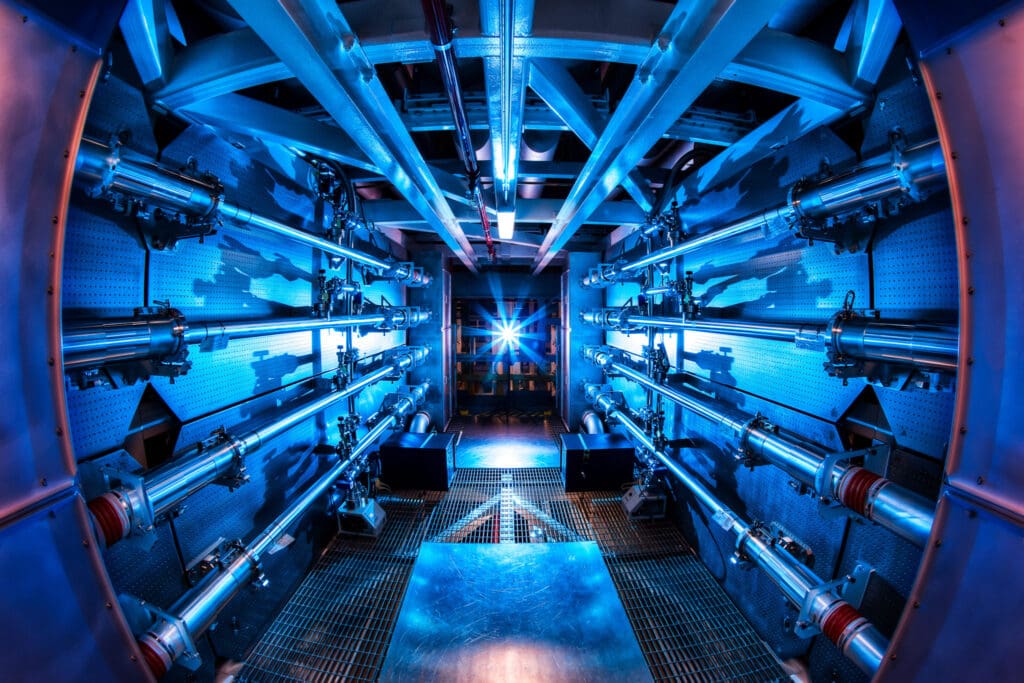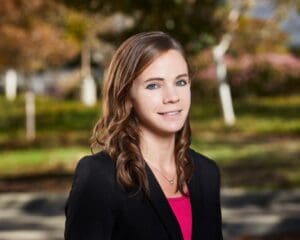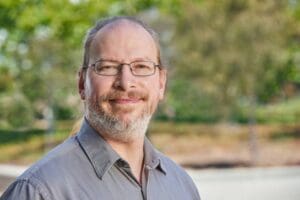Aggies Contribute To Nuclear Fusion Breakthrough
TEXAS A&M TODAY
Aggies Contribute To Nuclear Fusion Breakthrough
Two former students employed at Lawrence Livermore National Laboratory are among many people with ties to Texas A&M who played a part in the major scientific advancement.
By Mike Reilly, Texas A&M University System Marketing & Communications
December 15, 2022

Kelli Humbird, a nuclear engineer who graduated from Texas A&M University, describes the last 10 days as surreal.
Humbird is a design physicist at the Lawrence Livermore National Laboratory (LLNL) in California. She works on the team of scientists that predicted a major breakthrough in the field of nuclear energy was poised to occur.
And her team was right.

On Dec. 5, the lab used 192 giant lasers to ignite a nuclear fusion reaction unlike any before in human history. That’s because the fusion reaction produced more energy than it took to start the reaction.
The breakthrough, which was announced Tuesday, will advance U.S. nuclear deterrence and someday could lead to a new, abundant source of clean and safe energy to fuel everyday life.
“After it happened, I barely slept that night,” said Humbird, a Houston-area native who earned her Ph.D. from Texas A&M in 2019. “This is one of those moon landing kind of events. It can’t be emphasized enough how big of a deal this is.”
Energy Secretary Jennifer Granholm compared the breakthrough to the Wright brothers’ flight at Kitty Hawk. She and other top Department of Energy officials called it the culmination of 60 years of research and thousands of scientists’ work.
While there is no official count, there is also no doubt that many of those contributing scientists over the years have been Texas A&M graduates working at LLNL or faculty from Texas A&M who have worked closely with the lab.
For example, two Texas A&M professors of Industrial and Systems Engineering, Satish T.S. Bukkapatnam and Yu Ding, have helped LLNL engineer the type of capsule that contained the fuel for fusion on Dec. 5.
Lawrence Livermore has ongoing affiliations with Texas A&M in physics and math, as well as a range of engineering fields. LLNL workers train in high-explosive safety techniques at Disaster City in College Station, which is operated by the Texas A&M Engineering Extension Service (TEEX).
Even Lawrence Livermore Director Kim Budil is a graduate of an executive education program at the Texas A&M Bush School of Government and Public Service, a program tailored to meet the needs of the Department of Energy’s national security labs and facilities.
And then there is Marvin L. Adams, the renowned Texas A&M University nuclear engineering professor who has taken a leave of absence to serve as deputy administrator of DOE defense programs.

– Chip Somodevilla/Getty Images
He took to a podium in Washington D.C. Tuesday and explained to the world the experiment itself.
His role stems from his 30 years at Texas A&M, helping scientists at LLNL and the other national labs tackle daunting research challenges. He and other Texas A&M professors also have mentored generations of engineers, including many playing vital roles at the labs.
“I’m not surprised that Aggies played a significant part in a breakthrough like this,” said Interim Vice Chancellor and Dean of Texas A&M Engineering John E. Hurtado, who worked at Sandia National Laboratories early in his career.
“This is a special place. We have the largest nuclear engineering program in the country. We have renowned professors teaching, mentoring and guiding these students, who then have opportunities to go to the national labs when they graduate.”
Michael Zika, 53, went straight to Lawrence Livermore upon getting his Ph.D. from Texas A&M in 1997.
Now the Deputy Program Director for Weapons Physics and Design, Zika has designed other experiments for the giant facility used on Dec. 5. The National Ignition Facility has the world’s largest, most precise and reproducible laser system. It’s the size of a sports stadium and produces the extreme conditions needed for the most sophisticated experiments.
“This is, literally, center of the sun kinds of extremes,” Zika said. “This is a remarkable facility, a global gem.”

– Courtesy photo
Zika was Adams’ first Ph.D. student starting in January of 1993. Originally from Ohio, he earned his bachelor’s and master’s degrees in nuclear engineering from PurdueUniversity.
Adams had just joined the faculty after more than five years at LLNL as a computational physicist.
“I went to Texas A&M because of Marv Adams,” Zika said. “He had been doing just what I wanted to do and what I have done in my career. He was — and is — a fantastic mentor and friend.”
Following the Dec. 5 breakthrough, test results were reviewed for several days internally and by an independent outside panel of experts to ensure they were accurate before they were announced to the world.
Humbird and her teammates waited anxiously.
“It was surreal,” she said by telephone from the lab. “After it happened, our team was thrilled. We were exchanging emails and plotting preliminary data onto our expectations. The figures we sent around — everything just kind of lined up. Then it started to sink after a couple days. This looks like it’s going to be a really, really big result.”
Humbird, 31, joined LLNL in 2017 as a student researcher and completed her Ph.D. research at the lab. She also has bachelor’s and master’s degrees in nuclear engineering from Texas A&M.
“I got a fantastic education,” she said. “I was so well-prepared with physics and engineering understanding when I got here. It really kind of surprised me. My favorite part of that university was the relationships that I got to build with my professors. They were never too busy for you.”
Humbird took classes from Adams, who served on her Ph.D. committee and now reviews her work at LLNL.
“It is kind of a joke we share because he was my professor, he graded my exams, he graded my Ph.D., and he’ll just be reviewing me for the rest of my career,” she said. “It was cool to see him up on the stage this week and to know how many students that he’s impacted, inspired and set on career paths.”
https://today.tamu.edu/2022/12/15/aggies-contribute-to-nuclear-fusion-breakthrough/
About The Texas A&M University System
The Texas A&M University System is one of the largest systems of higher education in the nation, with a budget of $7.2 billion. Through a statewide network of 11 universities, a comprehensive health science center, eight state agencies, and the RELLIS Campus, the Texas A&M System educates more than 152,000 students and makes more than 24 million additional educational contacts through service and outreach programs each year. System-wide, research and development expenditures exceed $1 billion and help drive the state’s economy.
Contact: Laylan Copelin
Vice Chancellor of Marketing and Communications
(979) 458-6425
(512) 289-2782 cell
lcopelin@tamus.edu
